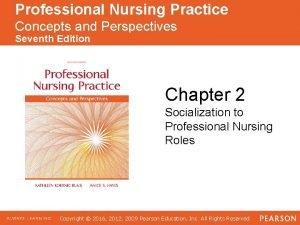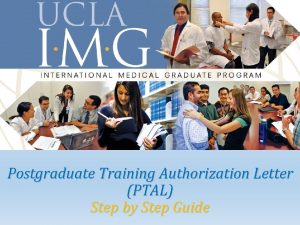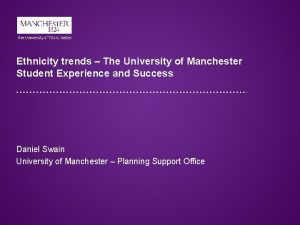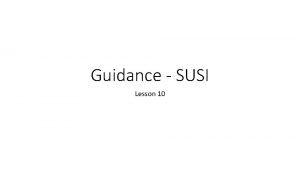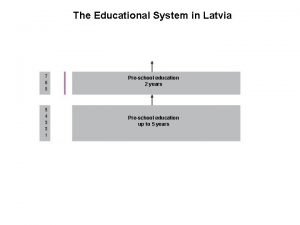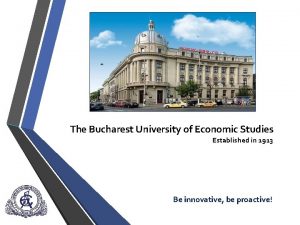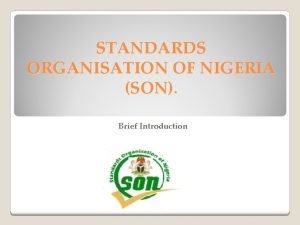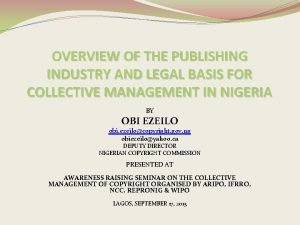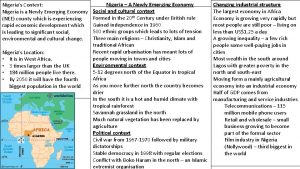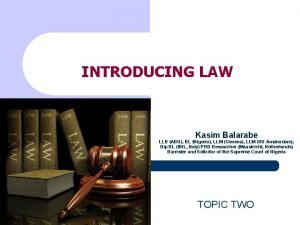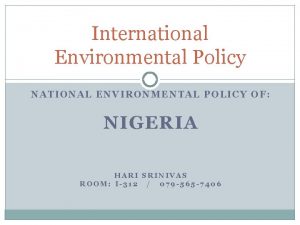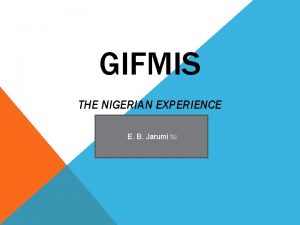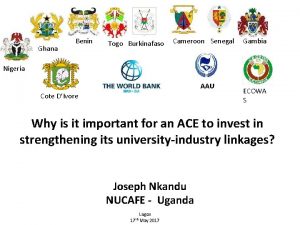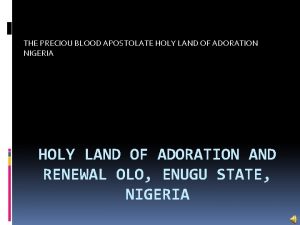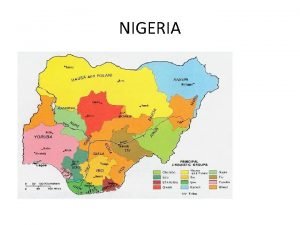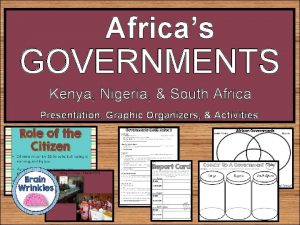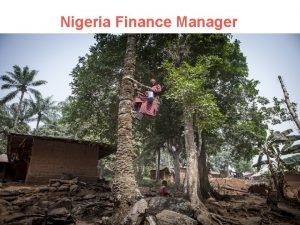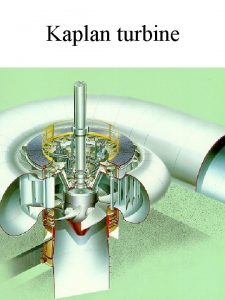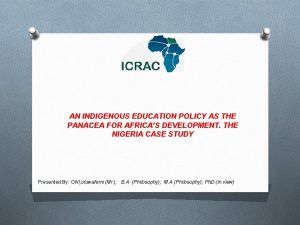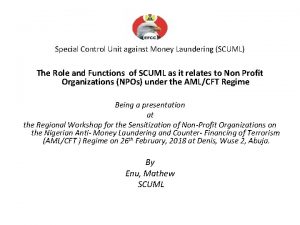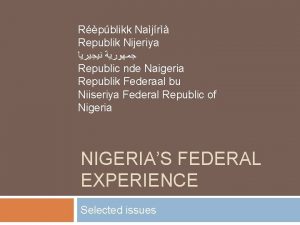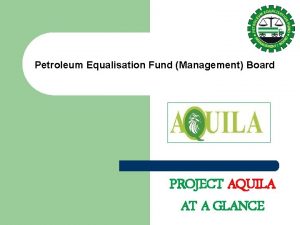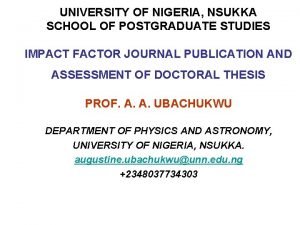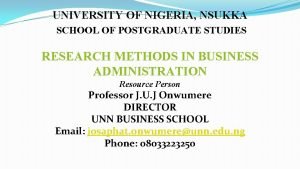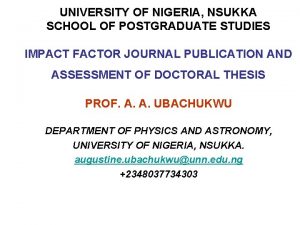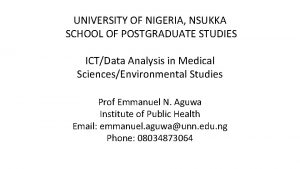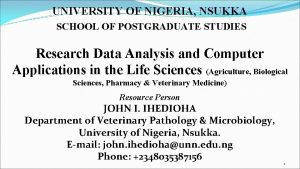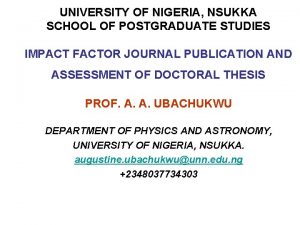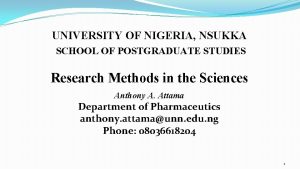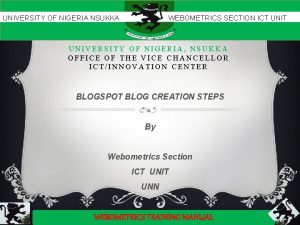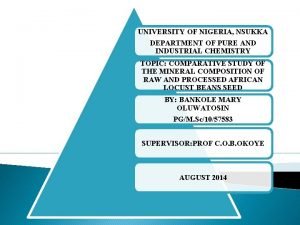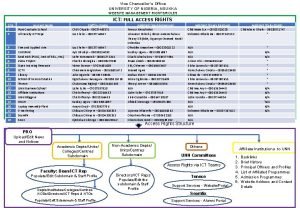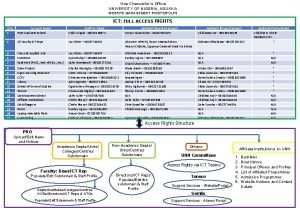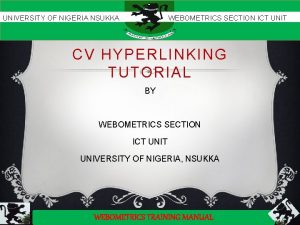UNIVERSITY OF NIGERIA NSUKKA SCHOOL OF POSTGRADUATE STUDIES










































- Slides: 42

UNIVERSITY OF NIGERIA, NSUKKA SCHOOL OF POSTGRADUATE STUDIES Research Grant Writing (Grantsmanship) Professor Kenneth C. Ofokansi Department of Pharmaceutics University of Nigeria, Nsukka Email: kenneth. ofokansi@unn. edu. ng Phone: +23481 -31245821

PRESENTATION OUTLINE INTRODUCTION What is Research? What is a Research Proposal? What makes a Good Proposal? GOALS AND OBJECTIVES OF THIS PRESENTATION STRUCTURE OF A RESEARCH PROPOSAL Title Page Abstract/Executive Summary Project Background/Introduction o Objectives Literature Review

STRUCTURE OF A RESEARCH PROPOSAL CONTD’ Methodology Expected Outcomes Work Schedule/Budget References Attachments

INTRODUCTION (GENERAL INFORMATION ON GRANT WRITING What is Research? “A diligent and systematic inquiry or investigation into a subject in order to discover facts and principles”.

What is a research proposal? -a request for financial assistance to implement a scientific project or study

Good proposals quickly and easily answer the following key questions: v What do you want to do, how much will it cost and how much time will it take? v How does the proposed project relate to the sponsor’s interest? v What has already been done in the area of your project? v How do you plan to do it? v How will the results be evaluated?

Summarily, the objective in writing a research proposal is to describe: v What you will do v Why it should be done v How you will do it v What you expect will be the result In deciding on what you will do, first figure out the important and missing parts of our understanding.

WHAT MAKES A GOOD PROPOSAL Motivation and Scope What to investigate in a project? A new idea, e. g. , a first solution to an impacting problem A better solution to a known problem E. g. , a better‐performing algorithm (accuracy, speed, etc. ) Multidisciplinary ideas Knowledge gaps

GOALS AND OBJECTIVES OF THIS PRESENTATION By the end of this presentation, participants would be able to: Ø Understand discuss the trends and features of grant-winning proposals Ø Understand the various practical approaches to writing proposals

STRUCTURE OF A RESEARCH PROPOSAL Title v. An effective title attracts the reader’s interest. v. It should be comprehensive enough to indicate the nature of the proposed work v. Should be precise, specific and descriptive

An appealing project identifier – Should briefly and rigorously summarize the essence of the project • Attractive, objective, precise, fully descriptive, concise and clear title – Should be specific (not too general)

Abstract/Executive Summary Usually one page abstract/executive summary of the research proposal. It should be short, precise and complete. The abstract of Biological Research must in brief contain the following points - Background - Aim of the Research - Methods used - Results - Conclusion of the research experiment

Like the title, abstract should be brief and rigorously summarize the essence of the project, now with a few more words (typically, between 200 and 400 words) • Like the title, may be the only thing evaluators read – If it is not catchy, the proposal may be excluded without further reading

The funder may use the abstract to make preliminary decisions about the proposal. An effective summary states the problem addressed by the proposer, identifies the solution, and specifies the objectives and methods of the project. Project Background/Introduction Statement of the problem or gap in the current research in your field of study. Introductory paragraphs Statement of the Problem Significance of the Study

The introduction begins with a general statement of the problem area With a focus on research problems to be followed by the Rationale/Justification for the proposed study. should stress the research problem, which is often referred as purpose of the study

Rationale , Justification States the Research Questions, its importance Major problems and sub problems to be addressed by research Presents rationale of the proposed study and indicates why it is worth doing.

STATEMENT OF THE PROBLEM IT IS JUST ONE SENTENCE (WITH SEVERAL PARAGRAPHS OF ELABORATION). YOU ARE LOOKING FOR SOMETHING WRONG. . . OR SOMETHING THAT NEEDS CLOSE ATTENTION. . OR EXISTING METHODS THAT NO LONGER SEEM TO BE WORKING.

SIGNIFICANCE OF THE STUDY IT POINTS OUT HOW YOUR STUDY RELATES TO THE LARGER ISSUES THE SIGNIFICANCE OF THE STUDY ANSWERS THE QUESTIONS: - WHY IS YOUR STUDY IMPORTANT? - TO WHOM IS IT IMPORTANT? - WHAT BENEFIT(S) WILL OCCURIF YOUR STUDY IS DONE?

Objectives A few typical statements are: The goal of this study is to. . . overcome the difficulty with. . . discover what. . . understand the causes or effects of. . . refine our current understanding of. . . provide a new interpretation of. . . understand what makes successful or unsuccessful

Literature Review Context in which the problem arises; historical and current researches in the field • Important - shows what previous researchers have discovered (and have not discovered). • *One of the key elements that proposal readers look at, when deciding whether or not to approve a proposal. Never say that your area is so new that no research exists.

Methodology State clearly how you plan to conduct your research: What methodology are you using? Why? What information needs to be gathered? Will this data be applicable to the research questions? Who or what will you use as the data source? How will you collect data or construct experiments? What controls are in place? How will the data be analysed? Do you need ethics approval?

Expected Outcomes Predicted results Expected contribution to knowledge

PREPARING TO WRITE Grant guidelines Checklist of required proposal elements Key points for effective writing General proposal construction tips

CONSTRUCTING THE PROPOSAL SECTIONS Eligibility Project Abstract Statement of Need Project Description Goals and Objectives Project Activity Plan Capacity and Commitment Evaluation Plan Budget

PROJECT ABSTRACT Captures reader’s attention Clear, concise description of full project Highlights of each major proposal section

STATEMENT OF NEED Need or problem to be addressed Consistent with grantor agency’s goals Documentation of need/problem Current or previous efforts Reasonableness of scope Chances of success

PROJECT DESCRIPTION Narrative (more is not always better) What you will do to address the need Project scope: How big? How small? Project structure: Sub grants? Partners? Target population Rationale for approach Planned outcomes

Goals - consistent with grant guidelines Objectives - specific, measurable, and clearly support the goals

WRITING GOOD OBJECTIVES Action and Standard Statement of expected outcome Measurable, observable action Timelines for achievement

Properly constructed, logically sequenced activities Support achievement of objectives Responsible persons Documentation of completed activities Timelines for completion

WORK SCHEDULE/PLAN

Academic outcomes – academic contributions at theoretical and empirical levels Social outcomes – social benefits Policy outcomes – specific policy recommendations

EVALUATION PLAN Determining project success Link to planned outcomes – how to measure Types of data to be collected Plan to analyse data Use of data to make project improvements

BUDGET Funds you need to implement the project Resources you will contribute (if any) Project sustainability Proposed expenses linked to specific activities Accurate and complete cost basis Necessary, reasonable, allocable

Dissemination Plan Goal Channels and the actions to publicly disseminate the project results How? Project identity For all public communication Internet Project homepage Scientific publications and events Press releases Attained results Demo installations

SUBTLE MISTAKES TO AVOID Missing the proposal deadline Omitting a required component Vague descriptions Budget not linked to activities Budget exceeds maximum allowed Project is inconsistent with guidelines

There a number of International resources available on the web as sources of international grants namely: Action Without Borders: Idealist: www. idealist. org World Bank: www. worldbank. org US Agency for International Development: www. usaid. gov Charities Aid Foundation: www. cafonline. org Institute for Global Communications: www. igc. org Grand Challenges, Canada Bill and Balinda Foundation

WHAT HAVE LEARNT FROM THIS PRESENTATION? Please share with this audience

SUMMARY/RECOMMENDATIONS/CONCLUSION 14 REASONS WHY PROPOSALS FAIL Deadline not met Guidelines not followed Nothing intriguing Did not meet priorities Not complete Poor literature review Appeared beyond capacity of PI Methodology weak Unrealistic budget Cost greater than benefit Highly partisan Poorly written Mechanical defects

REMEMBER Get Read Follow The Guidelines

RECYCLE YOUR REJECTED PROPOSAL Success means having one in three grants funded A rejected proposal does not always mean the idea was rejected Obtain reviewer comments Call the program officer Rewrite, revise, resubmit

THANK YOU The End
 Ajou university gsis
Ajou university gsis Jane jacobs columbia university school of general studies
Jane jacobs columbia university school of general studies Kramer's postgraduate resocialization model stages
Kramer's postgraduate resocialization model stages Undergraduate graduate postgraduate
Undergraduate graduate postgraduate Ptal california letter
Ptal california letter Difference between postgraduate and undergraduate
Difference between postgraduate and undergraduate Difference between postgraduate and undergraduate
Difference between postgraduate and undergraduate Susi postgraduate rates
Susi postgraduate rates Clinical governance postgraduate
Clinical governance postgraduate Belarusian medical academy of postgraduate education
Belarusian medical academy of postgraduate education Postgraduate education
Postgraduate education Alexmed postgraduate
Alexmed postgraduate Paradigm shift from women studies to gender studies
Paradigm shift from women studies to gender studies Herszon kherson maritime college of merchant marine fleet
Herszon kherson maritime college of merchant marine fleet Bucharest university of economic studies
Bucharest university of economic studies Beijing foreign studies university accommodation
Beijing foreign studies university accommodation Son standards
Son standards Laws guiding book publishing in nigeria
Laws guiding book publishing in nigeria Nigeria newly emerging economy
Nigeria newly emerging economy Universities that offer pharmacy in nigeria
Universities that offer pharmacy in nigeria Kasim balarabe
Kasim balarabe Mobil livesco
Mobil livesco Gifmis
Gifmis Xxxvideo togo
Xxxvideo togo Historical perspective of community development
Historical perspective of community development Máscara de cultura isoko nigeria
Máscara de cultura isoko nigeria Precious blood apostolate olo-nigeria
Precious blood apostolate olo-nigeria White fathers in nigeria
White fathers in nigeria Norjan pinta-ala
Norjan pinta-ala What are the 250 ethnic groups in nigeria
What are the 250 ethnic groups in nigeria Nhmis nigeria
Nhmis nigeria Challenges of immunization in nigeria
Challenges of immunization in nigeria How do the governments of kenya and nigeria compare?
How do the governments of kenya and nigeria compare? Nigeria folk tales
Nigeria folk tales United purpose nigeria
United purpose nigeria Natural resources in nigeria
Natural resources in nigeria Nigeria
Nigeria Kaplan turbine
Kaplan turbine Coca cola nigeria
Coca cola nigeria Indigenous education in nigeria
Indigenous education in nigeria Scuml
Scuml Nigeria map with states
Nigeria map with states Petroleum equalization fund
Petroleum equalization fund


